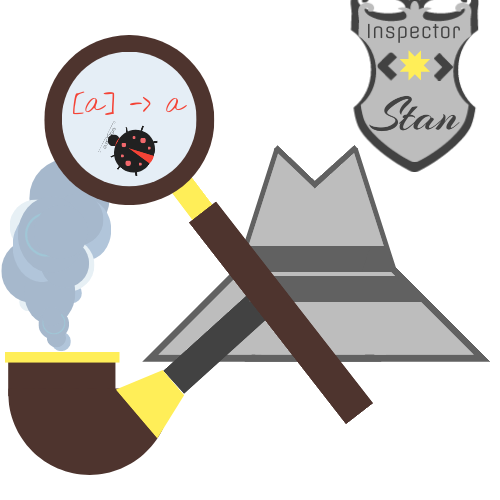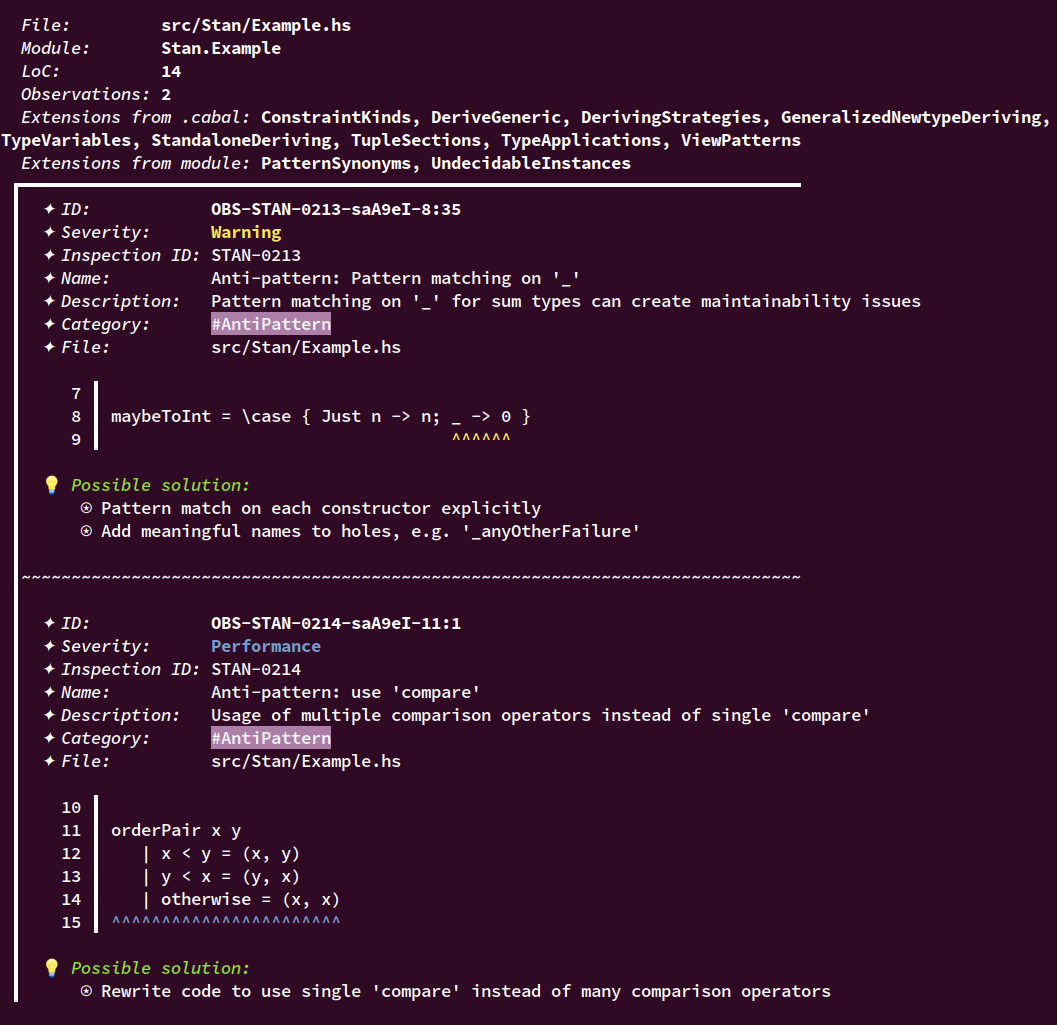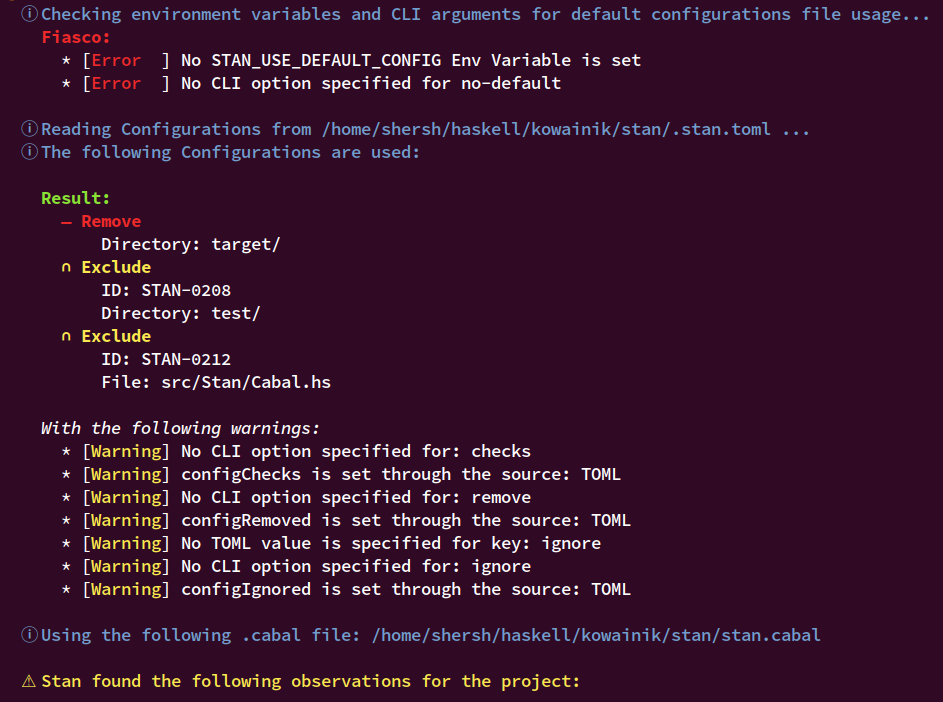Stan




Stan is a Haskell STatic ANalysis tool.
⚠️ Note: Stan is in the beta phase. The API is the subject to be
changed if required by our needs ⚠️
Table of Contents
[Back to the Table of Contents] ↑
Stan is a command-line tool for analysing Haskell projects and
outputting discovered vulnerabilities in a helpful way with possible
solutions for detected problems. Stan is searching for not only
performance or error-prone code pieces, but it also can help with
establishing and applying best-practices from the whole Haskell
ecosystem.
Although Haskell is a statically typed language, not all properties
can be encoded in types. Even though GHC is quite a powerful compiler,
it tries to be library-agnostic and provide only language-specific
suggestions, while Stan uses the knowledge about the current state of
the ecosystem and commonly used libraries.
You will find Stan helpful if you enjoy writing in Haskell, but want
more guarantees from your code, not provided by the Haskell type
system or GHC.
Goals
[Back to the Table of Contents] ↑
Stan design and implementation is driven by the following goals:
- Catch common vulnerabilities, anti-patterns, performance issues
- Provide meaningful insights on the projects generally
- Point out potential bugs and weak points in the programs flow for
users, so they can carefully evaluate each problem with the code
- Help beginners to learn best practices in an easy and informative way
- Generate the report that can be used as a proof of code quality
- Create best in the class and flexible enough interface for usage
(including e.g. opt-in and opt-out inspections)
Features
[Back to the Table of Contents] ↑
Stan is a configurable CLI tool. Besides the main feature of analysing
Haskell projects statically, Stan has a list of features that make it
unique, easy to use and flexible to configure:
- Pretty analysis results, including both HTML and terminal reports
- Suggestions and possible solutions for fixing the existing problems
- Analysing not only Haskell source code, but also information from
the
.cabal files
- Flexible runtime configuration via TOML and CLI
You can see an example of Stan HTML report hosted online here:
The below example of the terminal output gives you the understanding
of what sorts of analysis you can expect from Stan:

How it works
[Back to the Table of Contents] ↑
Stan analysis is based on the HIE files — compile-time
information about Haskell source code gathered and recorded by
GHC. The HIE files contain the Haskell AST, detailed information about
each identifier and types of all expressions and sub-expressions. GHC
does a huge amount of work when compiling the Haskell projects, and
Stan takes advantage of this feature to avoid duplicating the work and
focus more on the unique features.
To analyse HIE files easily, we developed an eDSL for defining AST and
Type patterns based on the
final taggless
approach. Stan algorithm traverses HIE AST for each HIE file in the
project, and matches every AST node with the given pattern to find
potential vulnerabilities in the code.
Each Stan analysis check is represented by the inspection with the
unique ID. Each inspection has a name, description, severity, list
of categories, pattern for matching relevant parts of source code
and possible solutions to the problem.
When an inspection is casted on the project, it produces zero or more
observations — vulnerabilities in the specific parts of the
code. You can think of an observation as a pair of an inspection and
a piece of source code where this inspection was triggered. Each
observation is assigned an unique stable ID depending on the source
location, so you can refer to them later or ignore.
You can disable inspections or enable them only in particular modules
using check — rules for controlling which inspections to run and
where. Each check has a type (include or exclude), filter
(by inspection id, category, severity, etc.) and scope (file,
directory, everything). Checks can be specified using either TOML of
CLI interfaces. By default, Stan analyses all source files using all
implemented inspections.
If you want to understand Stan terminology better, refer to the
glossary:
Installation instructions
[Back to the Table of Contents] ↑
Stan takes advantage of the
GHC API to provide its
analysis. Because of this, Stan and the analysed project need to be
built with the same GHC version (for more details see
#178). That is why the
easiest and most robust way to install Stan is to build it from
sources on your machine.
Note: Stan is compatible with the GHC versions ⩾ 8.8
Using Cabal
[Back to the Table of Contents] ↑
Below are the steps to install Stan using the Cabal build tool.
You need to have Cabal ⩾ 2.4
First, you need to clone the repository:
$ git clone https://github.com/kowainik/stan.git
$ cd stan
Then, you need to build it using Cabal:
$ cabal v2-build exe:stan
Finally, you can copy the resulting executable under the desired
location (that should be under the PATH environment variable), like
so:
$ cp dist-newstyle/build/x86_64-linux/ghc-8.8.3/stan-0.0.0.0/x/stan/build/stan/stan ~/.local/bin/stan
The path to the executable will be outputted as the last line of the
previous command.
Using Stack
[Back to the Table of Contents] ↑
Below are the steps to install Stan using the Stack build tool.
You need to have Stack ⩾ 2.1.3
First, you need to clone the repository.
$ git clone https://github.com/kowainik/stan.git
$ cd stan
Then, you need to build it using Stack:
$ stack build
Finally, you can copy the resulting executable under the desired
location (that should be under the PATH environment variable), like
so:
$ cp "$(stack path --local-install-root)/bin/stan" ~/.local/bin/stan
Usage instructions
[Back to the Table of Contents] ↑
Stan works with the HIE files to analyse Haskell
projects. Therefore, Stan requires users to generate HIE files in
advance. Fortunately, it is straightforward to satisfy this
necessity. To produce HIE files, add the following GHC options in your
project's .cabal file to each stanza you want to analyse:
ghc-options: -fwrite-ide-info
-hiedir=.hie
Recommendation: you can use the common
stanzas feature to
write the above options only once and enable them in each stanza
easily.
Note: here we recommend generating the HIE files into .hie/
folder. As it is the recommendation only, you can specify your own
folder as well. But then you will need to run stan using the
--hiedir option with the specified path to your hie folder.
After creating HIE files, you can just run Stan on the project:
$ stan
to see all found vulnerabilities in your terminal.
If you want to see a more detailed information in a more structured
way, you can generate an HTML report (to the stan.html file) using
the following command:
$ stan report
Stan strives to implement the convenient interface, so you can use the
tool without configuring a lot in advance. However, the tool also
provides various ways to set it up in the way to be the most efficient
with your particular use case.
General configuration info
[Back to the Table of Contents] ↑
Stan's work can be configured from the multiple sources (in increasing
order of priority):
- Default settings (hard-coded in the library — includes no
custom settings)
- Environment variables
- TOML file configuration
- CLI arguments
Stan runtime settings have many parts, and each of them can come from
different configuration sources. If some option is specified through
multiple sources, the most prioritized one will be used. In addition,
Stan helps to understand its own configuration, so it outputs detailed
information about each part of the config, what configuration settings
were used and how they were set.

TOML configurations
[Back to the Table of Contents] ↑
Stan supports TOML runtime configuration in order to customize
the work of the tool based on the user's individual requirements. You
can use the TOML configuration to disable some inspections, enable
them only in particular Haskell modules, ignore some observations or
completely remove some files from the analysis.
See Haddock documentation for explanation of how the TOML
configuration works and examples of the different use cases.
In case you have a number of TOML files locally, the following rules
describe how Stan decides which TOML configuration file to use:
- By default, Stan tries to read settings from the local
.stan.toml
file in the current directory. So, if you want to adjust the default
Stan settings with some custom rules, create a .stan.toml file in
the root of your Haskell project.
- If the local
.stan.toml file is not found, Stan tries to read the
global ~/.stan.toml file. Having a global Stan configuration can
be convenient, if you work on several projects and want to have the
same custom settings by default for all of them.
- If you don't have any of the default configuration files, it is
still okay. Stan will use its own default hard-coded settings.
- You can specify a path to a specific configuration file using the
--config-file option. This custom file will be used in addition to
the default TOML config.
- If you don't want to use the default TOML configuration, pass the
--no-default flag or use the STAN_USE_DEFAULT_CONFIG=False
environment variable.
Command-line Interface
[Back to the Table of Contents] ↑
This section describes what is possible to achieve with the Stan
CLI. If you have already installed the analyser, you can use
$ stan --help
to get the short information of all possible commands and options in
your terminal.
Main command
[Back to the Table of Contents] ↑
The main command is the one that actually would analyse the Haskell
codebase. There are plenty of configurations and options you can tune
for each run (similarly to the TOML configurations):
- Specify the HIE files folder (will use
.hie/ otherwise)
- Specify
.cabal files of your project (will lookup automatically
otherwise)
- Turn on/off the usage of the default
.stan.toml configuration file
- Specify the TOML configuration file to use (will be used
additionally to default TOML file if applicable)
- Filter in or out specific files, directories, inspections,
categories or severities
- Generate the HTML report file
- Set up the output verbosity
More precisely the commands and options are described in here:
stan
[REPORT]
[ CHECKs {[TYPE option] [FILTER option] [SCOPE option]}
| REMOVEs {SCOPE option}
| IGNOREs {ID option}
]
[--hiedir=DIR_PATH]
[--cabal-file-path=FILE_PATHs]
[--config-file=FILE_PATH]
[--no-default]
[-s|--short]
[--hide-solution]
[-h|--help]
[-v|--version]
Description:
CHECKs Command to Specify the list of checks
REMOVEs Command to Specify scope to be removed
IGNOREs Command to Specify the list of what needs to be ignored
REPORT Command to generate an HTML Report
--hiedir=DIR_PATH Relative path to the directory with HIE
files (default: .hie)
--cabal-file-path=FILE_PATHs
Relative path to the .cabal file (can specify many of this option)
--config-file=FILE_PATH Relative path to the .toml configurations file
--no-default Ignore local .stan.toml configuration file
-s,--short Hide verbose output information for observations
--hide-solution Hide verbose solution information for observations
-h,--help Show this help text
-v,--version Show Stan's version
Sub-commands options:
TYPE:
--include Include check
--exclude Exclude check
FILTER:
--id=INSPECTION_ID Inspection ID to be used
--severity=SEVERITY Inspection Severity to exclude or include
--category=CATEGORY Inspection Category to exclude or include
--filter-all Exclude or include ALL inspections
SCOPE:
--file=FILE_PATH File to exclude or include
--directory=DIRECTORY_PATH
Directory to exclude or include
--scope-all Apply check to all files
For example, if you want to run Stan analysis only on a single file,
you can use the following command:
$ stan check --exclude --filter-all --scope-all \
check --include --filter-all --file=src/Stan/Example.hs
Inspections
[Back to the Table of Contents] ↑
You can find the list of all available inspections with description
and additional information on our
dedicated wiki page. However, with the tool you can get
this information easily by using the inspection command. Optionally,
you can see details of a particular inspection by typing the
corresponding inspection ID alongside. You can see more robust
description of the command here:
inspection – Show all Inspections
Usage:
stan inspection [INSPECTION_ID]
Available options:
INSPECTION_ID Show specific Inspection information
-h,--help Show this help text
Converting between TOML and CLI configurations
[Back to the Table of Contents] ↑
It is usually convenient to have a proper configuration file that
suits your project, which you can reuse each run of the Stan.
But sometimes you need to quickly run the tool with the same settings
on another machine where having such files is not possible. Or you
want to send the reproducible command, that anyone could execute and
get the identical results. For these purposes, we have a special
command that allows you to do so:
toml-to-cli – Convert TOML configuration file into stan CLI command
Usage:
stan toml-to-cli [--config-file=FILE_PATH]
Available options:
--config-file=FILE_PATH Relative path to the .toml configurations file
-h,--help Show this help text
And for convenience you are able to use the reversed command –– cli-to-toml.
cli-to-toml – Convert CLI arguments into stan TOML configuration
Usage:
stan cli-to-toml
[--config-file=FILE_PATH]
[ CHECKs {[TYPE option] [FILTER option] [SCOPE option]}
| REMOVEs {SCOPE option}
| IGNOREs {ID option}
]
Roadmap
[Back to the Table of Contents] ↑
Our plan for the nearest future:
We have much more ideas to work on.
See more detailed plan in the dedicated GitHub Project page.
Links to Wiki
[Back to the Table of Contents] ↑




